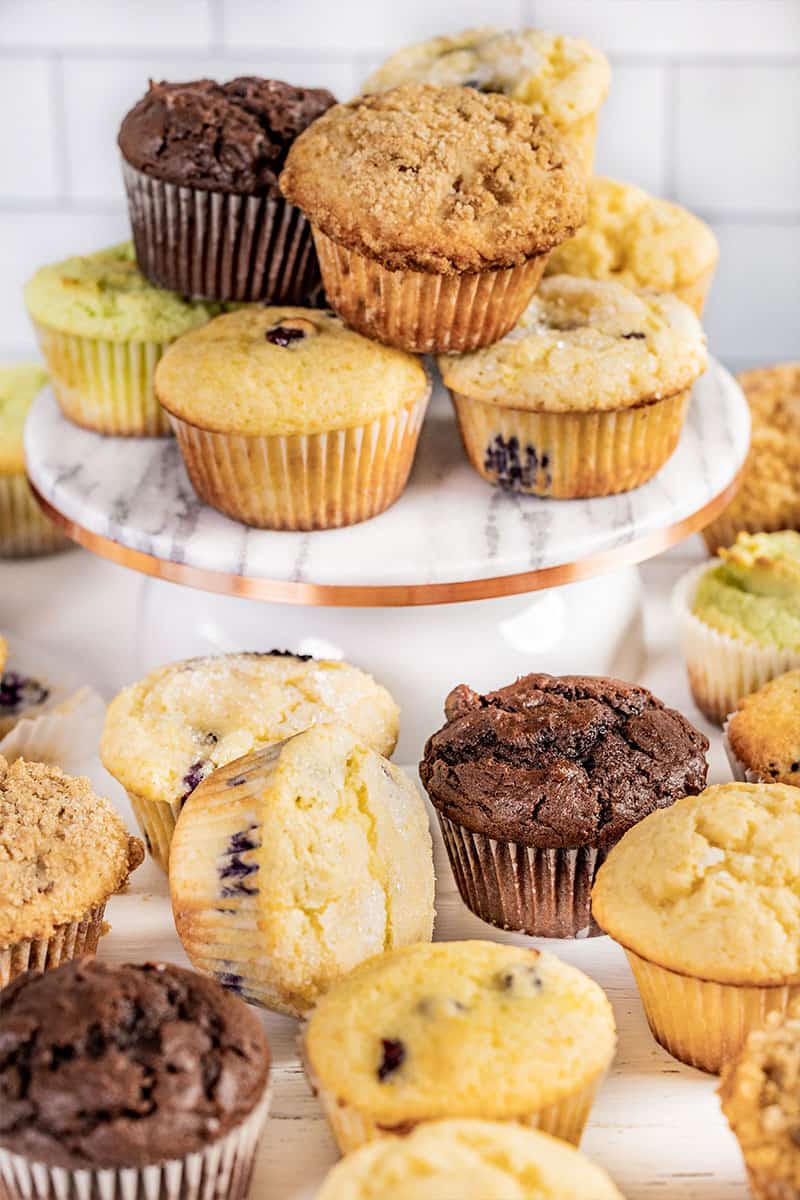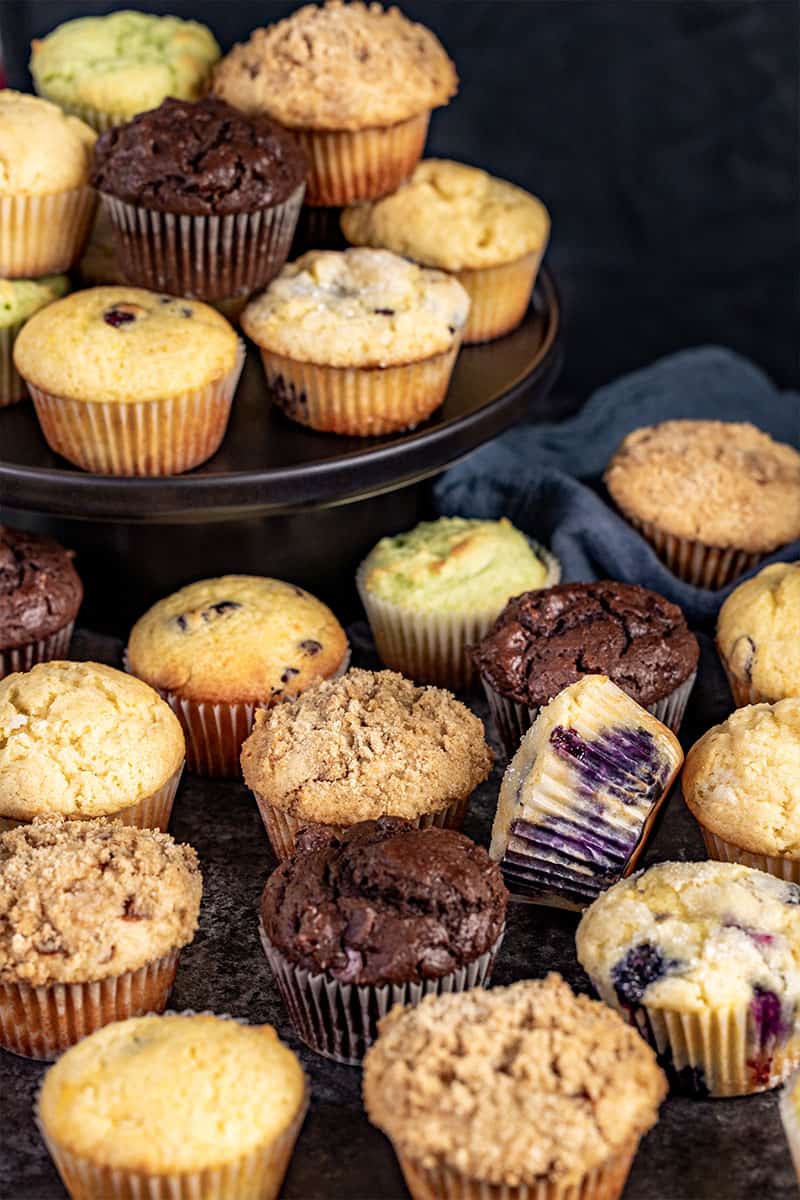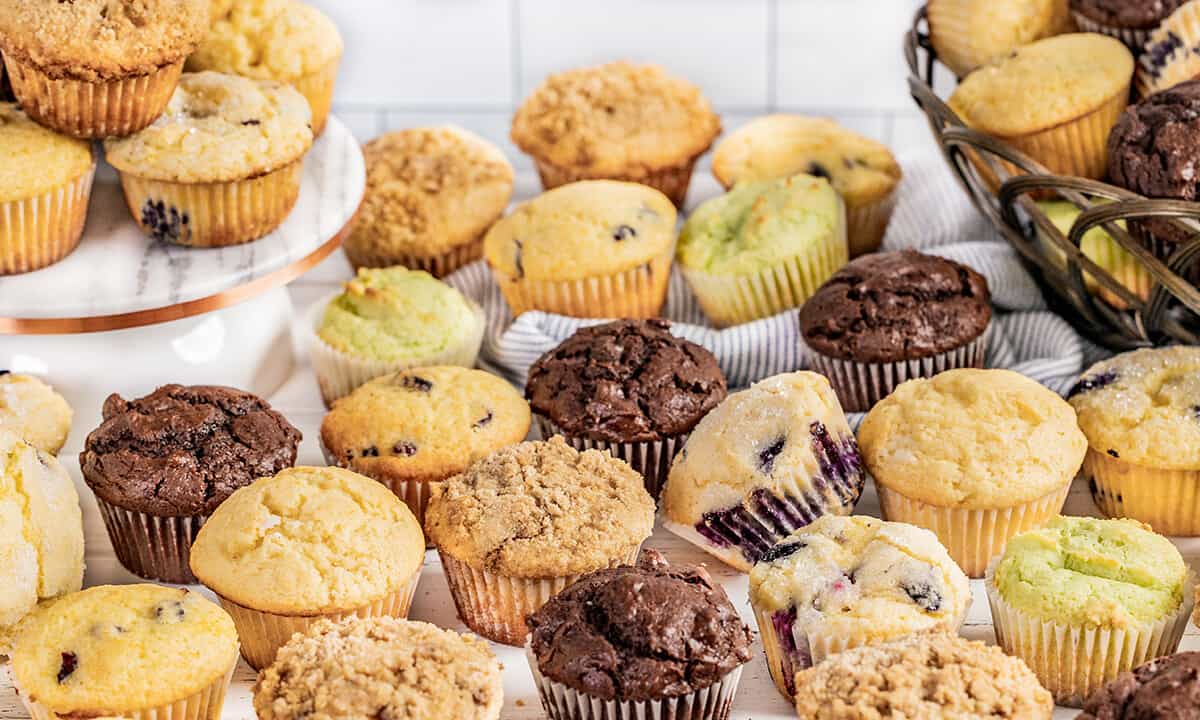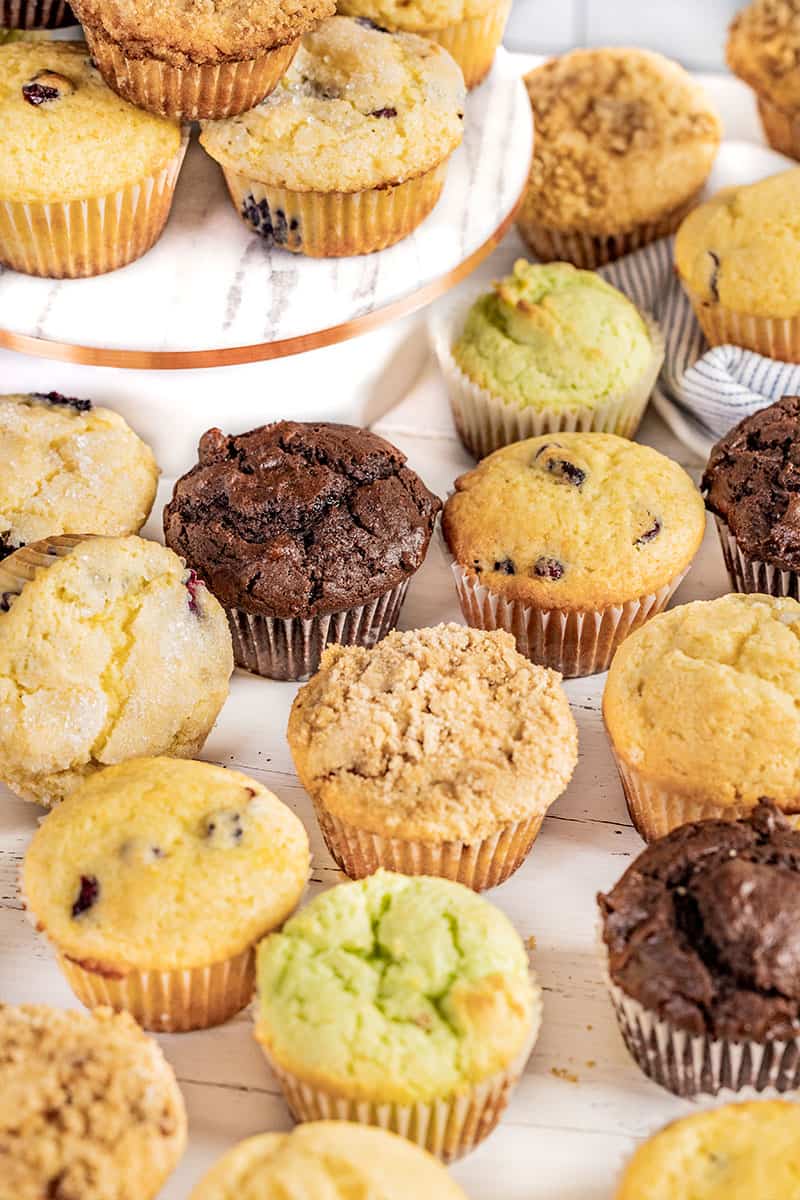Use one recipe to create any flavor of muffin in any size. There are so many different homemade muffin options out there that you’ll never get bored. We’ve come up with this easy and simple base recipe for all of your muffin-making needs. We’re outlining some of our favorite flavors and variations below, as well as some helpful tips. Our basic homemade muffin recipe will give you moist, fluffy, and delicious results every time.
For another master recipe for breakfast, you should check out our guide to homemade scones!
Why Our Recipe
- One recipe to rule them all with endless possibilities for add-ins, flavorings, and toppings, allowing you to create any flavor you can imagine.
- A blast of heat helps the muffins get a high rise with a soft crumb every time.
- Basic pantry staples are all it takes to whip up the perfect muffin at home.

Whether you’re in the mood for classic blueberry, rich chocolate chip, or something brighter like lemon poppy seed, this base recipe has you covered. With just a few basic pantry staples, you’ll have everything you need to bake delicious muffins at home.
Ingredient Notes
- Butter: Use unsalted butter for better control over the salt content, or use salted for a less sweet muffin. Make sure it’s fully softened for easier creaming.
- Granulated Sugar: You can also use brown sugar in the same amount for a slightly richer, molasses-like flavor.
- Eggs: Use grade AA large eggs. If you have to substitute, use 1/4 cup per egg of unsweetened applesauce or mashed banana instead.
- Baking Powder: Make sure it is fresh. It does expire!
- Salt: Just using regular table salt here. Salt is a flavor enhancer.
- Vanilla Extract: Feel free to swap in other extracts like almond or lemon for a different flavor twist.
- All-Purpose Flour: Stick with all-purpose flour for the best texture. Bread flour also works, but results in a chewier muffin. Any use of whole wheat flour will result in a more dense muffin.
- Milk or Buttermilk: Buttermilk gives the muffins extra moisture and a slight tang. If using regular milk, you can substitute with non-dairy milk if needed. To make a quick buttermilk substitute, add 1 tablespoon of lemon juice or white vinegar to ½ cup of milk and let sit for 5 minutes.
Yummy Add-Ins
Now that we have our base recipe covered, it’s time for all the fun variations, starting with add-ins. You can mix and match these to your heart’s content. The total of all combined add-ins should be no more than 1 cup.
Chocolate Chips: Use milk chocolate, semi-sweet, white chocolate, or mini chocolate chips.
Cinnamon Chips: These tend to only be available during the fall/winter baking season, but they make for heavenly cinnamon or pumpkin muffins.
Fresh or Frozen Berries: Blueberries, raspberries, or chopped strawberries are all great options. No need to thaw frozen berries before use. Toss your berries in a little flour before folding them into the batter to prevent sinking.
Fresh Fruit: Finely diced apples, bananas, peaches, or pears can all be used Remove 1 tablespoon of liquid (milk) from the recipe for every 1 cup of fresh fruit.
Dried Fruit: Raisins, cranberries, chopped apricots, or dates for concentrated fruit flavor and a chewy texture.
Chopped Nuts: Add chopped pecans, walnuts, almonds, pistachios, or macadamia nuts. You just want to be sure they are finely chopped. It’s okay to only add 1/2 cup of nuts to avoid having an overly crunchy muffin.
Shredded Coconut: For a more tropical vibe, add in either sweetened or unsweetened coconut flakes. Like the nuts, you may want to limit the coconut flakes to 1/2 cup.
Seeds: Add poppy seeds, chia seeds, or even sunflower seeds. Add up to 3 tablespoons.
Citrus Zest: For citrusy flavors like lemon and orange muffins, you’ll want to use a citrus extract in place of the vanilla extract and you can add up to 2 tablespoons of zest.
Topping Options
Streusel Topping: Mix ½ cup all-purpose flour, ⅓ cup brown sugar, 1 teaspoon cinnamon, and ¼ cup cold butter (cubed). Blend until the mixture resembles coarse crumbs and sprinkle generously over each muffin before baking.
Oats and Brown Sugar: Combine ¼ cup rolled oats with ¼ cup brown sugar. Distribute evenly over muffin batter.
Chopped Nuts: Sprinkle ¼ to ⅓ cup of chopped nuts atop muffins before baking for a crunchy top.
Raw Sugar: Sprinkle about 1 teaspoon of granulated sugar or large sugar crystals over each muffin for a crunchy, sparkly top.
Fruit Slices: Arrange thin slices of apples, pears, or a few whole berries on each muffin for a tasty little decoration. Use about 2-3 slices or berries per muffin.

Adapting for Different Sizes
This Master Recipe was written for a standard-size muffin pan. As written, this recipe will yield 12 standard muffins. For all other pan sizes, adjustments will need to be made as follows:
For Mini Muffins: Bake at a consistent 350°F (177°C) for 10-12 minutes. Mini muffins bake quickly, so start checking for doneness at the 8-minute mark to prevent overbaking. The smaller size leads to faster cooking.
For Jumbo Muffin Pans: Start at 425°F (218°C) for the first 5-7 minutes to get a nice lift, then reduce the heat to 350°F (177°C) and bake for an additional 18-22 minutes. The total baking time will likely be 23-29 minutes, depending on your oven and the starting temperature of your batter.
For Texas-Size Muffin Pans: These muffins are larger than jumbo, typically measuring around 3 ½ inches in diameter or more. Start with the same baking method as jumbo muffins: bake at 425°F (218°C) for 5-7 minutes, then lower the heat to 350°F (177°C) and bake for an additional 25-30 minutes. The total baking time may extend up to 35 minutes depending on your pan size and oven.
Get Fluffier Muffins
If you follow the instructions on the recipe card you should get fluffy results. But if you want to make yours even lighter and fluffier, we have a useful tip for you. Make sure that the eggs, butter, and milk are at room temperature before you start mixing. It will form a much smoother batter that will naturally trap air before it goes in the oven. The trapped air then expands when baked, which will encourage your pastries to fluff up really nicely.
Storage & Freezing Instructions
Store muffins at room temperature in an airtight container or plastic bag for up to 3 days. To maintain moisture, you can place a paper towel at the bottom of the container and another on top of the muffins.
To freeze, let the muffins cool completely. Arrange them in a single layer on a baking sheet and freeze for 1-2 hours until firm. Once frozen, transfer the muffins to a resealable plastic freezer bag or airtight container. Store frozen for up to 3 months. Thaw muffins at room temperature for about 1-2 hours or overnight in the refrigerator.



They are growing very well and smell amazing. I bake a big batch every year for school and just found the mist uncomplicated recipe.Thank you